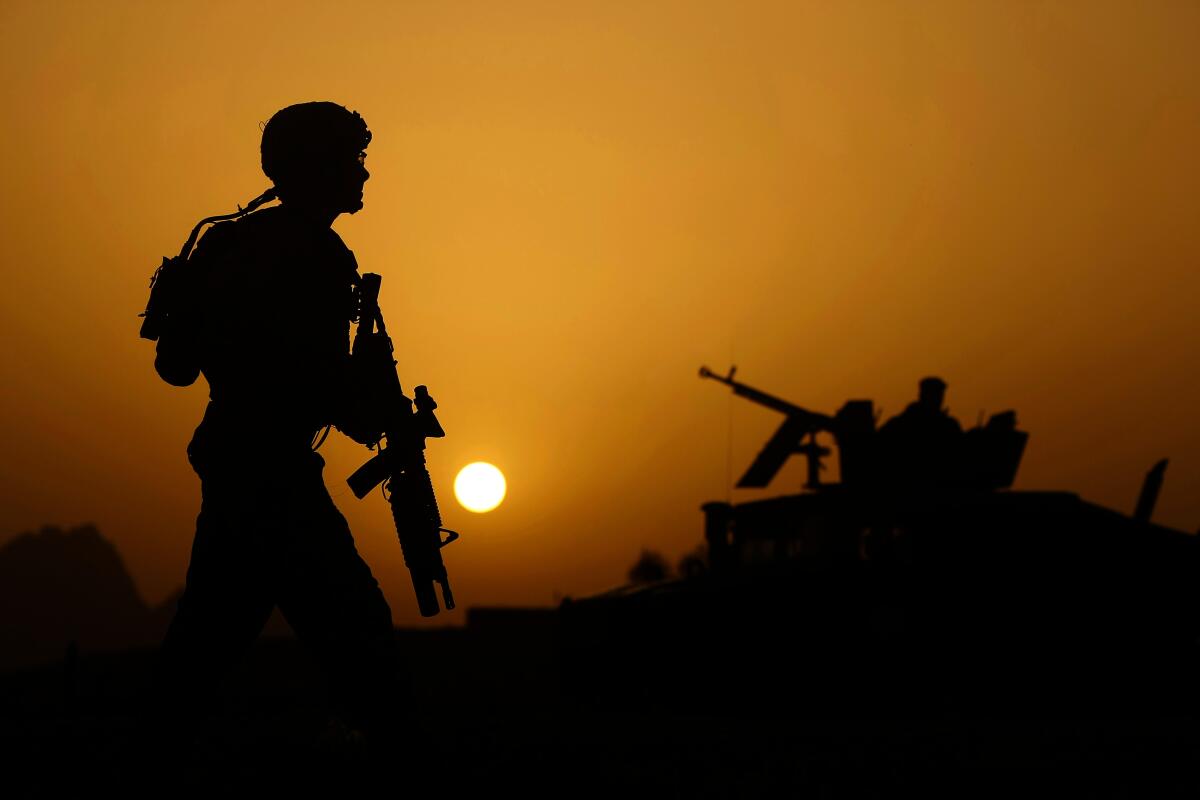The modest U.S. presence in Afghanistan was working

- Share via
Afghan President Ashraf Ghani has fled the country. His government has collapsed as Taliban fighters enter Kabul. Two decades of America’s military presence in Afghanistan have vanished in a matter of weeks. How did it come to this?
There are wars of necessity, in which military force is employed because it is deemed to be the best and often only way to protect vital national interests. There also are wars of choice, in which a country goes to war even though the interests at stake are less than vital and there are nonmilitary tools that can be employed.
Now, it seems, there are also withdrawals of choice, when a government removes troops that it could have left in a theater of operation. It does not withdraw troops because their mission has been accomplished, or their presence has become untenable, or they are no longer welcomed by the host government. None of these conditions applied to the situation the U.S. found itself in Afghanistan at the start of President Biden’s administration. Withdrawal was a choice, and, as is often true of wars of choice, the results promise to be tragic.
American troops first went to Afghanistan 20 years ago to fight alongside Afghan tribes seeking to oust the Taliban government that harbored Al Qaeda. The Taliban was soon on the run, although many leaders escaped to Pakistan, where over time they reconstituted themselves and resumed the fight against the Afghan government.
Troop numbers increased over the years — at one point during Barack Obama’s presidency to more than 110,000 — as U.S. ambitions in Afghanistan expanded. The cost was enormous: an estimated $2 trillion and close to 2,500 American lives, more than 1,100 lives of its coalition partners, as well as up to 70,000 Afghan military casualties and nearly 50,000 civilian deaths. The results, however, were modest: While an elected Afghan government (unique in the country’s history) controlled the big cities, its grip on power remained tenuous, and the Taliban regained control over many smaller towns and villages.
The U.S. intervention in Afghanistan was a classic case of overreach, a limited war of necessity initiated in 2001 that morphed over the years into a costly war of choice. But by the time Biden assumed the presidency, overreach was a thing of the past. American troop levels were down to around 3,000; their role was largely limited to training, advising and supporting the Afghan forces. There had not been an American combat fatality in Afghanistan since February 2020. The modest U.S. presence was both an anchor for some 8,500 troops from allied countries and a military and psychological backstop for the Afghan government.
In the U.S., Afghanistan had largely faded as an issue. After 20 years, the U.S. had reached a level of limited involvement commensurate with the stakes. Its presence would not lead to military victory or peace, but it would avert the collapse of a government that, however imperfect, was far preferable to the alternative that is now taking power. Sometimes what matters in foreign policy is not what you can accomplish but what you can avoid. Afghanistan was such a case.
But this was not U.S. policy. Biden was working from a script inherited from the administration of Donald Trump, which in February 2020 signed an accord with the Taliban (cutting out the government of Afghanistan in the process) that set a May 2021 deadline for the withdrawal of U.S. combat troops. The agreement did not oblige the Taliban to disarm or commit to a cease-fire, but only to agree not to host terrorist groups on Afghan territory. It was not a peace agreement but a pact that provided a fig leaf, and a thin one at that, for American withdrawal.
The Biden administration has honored this deeply flawed agreement in every way but one: the deadline for full U.S. military withdrawal was extended by just over three months. Biden rejected any policy that would have tied U.S. troop withdrawal to conditions on the ground or additional Taliban actions. Instead, fearing a scenario in which security conditions deteriorated and created pressure to take the politically unpopular step of redeploying troops, Biden simply removed all U.S. forces.
As was widely predicted, momentum dramatically shifted to the Taliban and away from the dispirited government after the announcement, and more so after the departure. With the Taliban taking control of all of Afghanistan, widespread reprisals, harsh repression of women and girls, and massive refugee flows are a near certainty. Preventing terrorist groups from returning to the country will prove far more difficult without an in-country presence.
Over time, there is the added danger that the Taliban will seek to extend its writ to much of Pakistan. If so, it would be hard to miss the irony, as it was Pakistan’s provision of a sanctuary to the Taliban for so many years that allowed it to wage war. Now, it is possible that Afghanistan will become a sanctuary for taking the war to Pakistan — potentially a nightmare scenario, given Pakistan’s fragility, large population, nuclear arsenal and history of war with India.
Biden was recently asked if he harbored any regrets about his decision to withdraw all U.S. troops from Afghanistan. He replied that he did not. He should.
Richard Haass, the president of the Council on Foreign Relations, is the author, most recently, of “The World: A Brief Introduction.”
More to Read
A cure for the common opinion
Get thought-provoking perspectives with our weekly newsletter.
You may occasionally receive promotional content from the Los Angeles Times.









